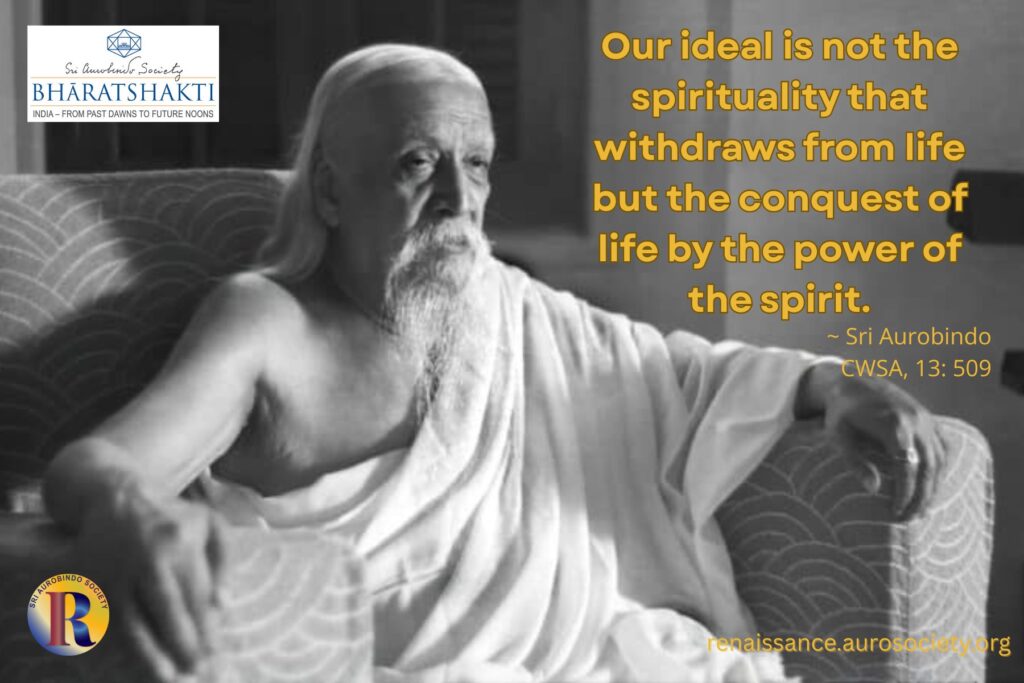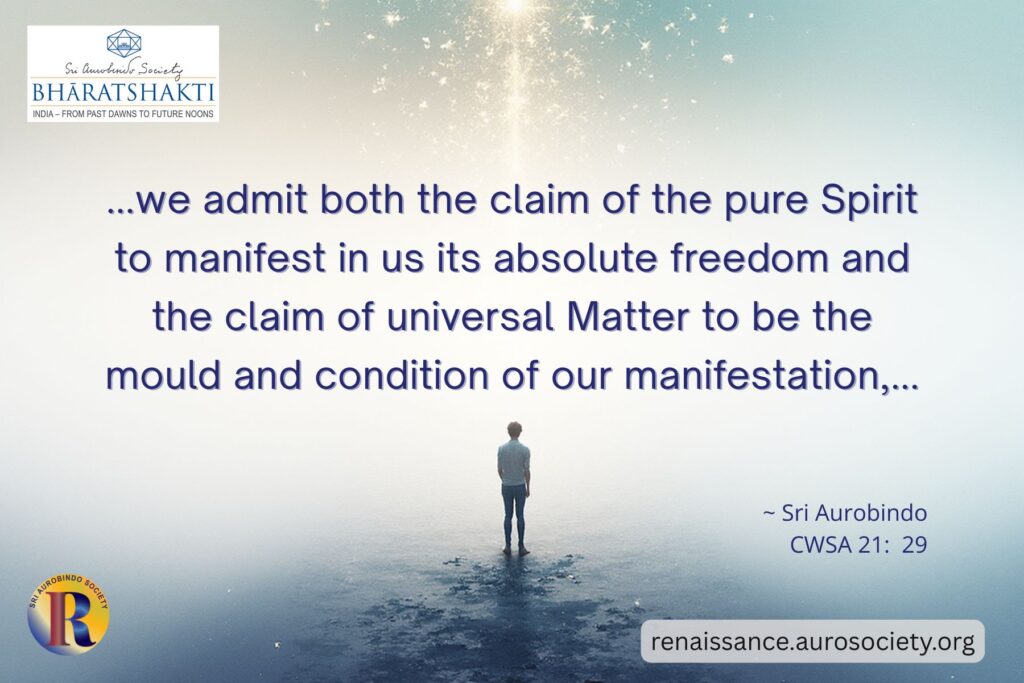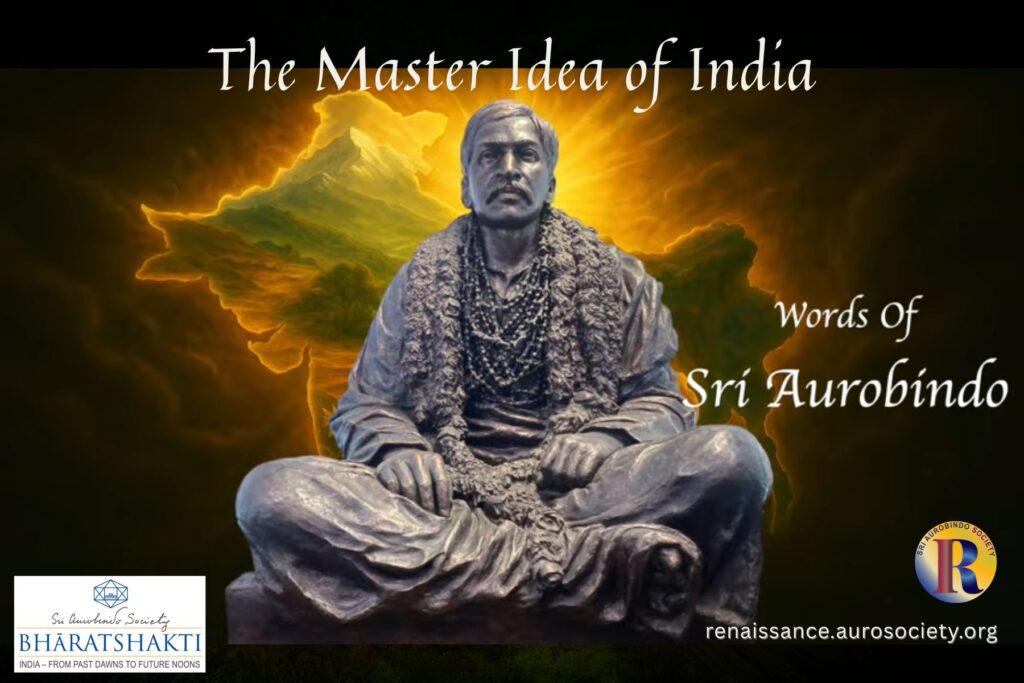Volume III, Issue 9
Author: Beloo Mehra
Grihastha life, meaning marriage and rearing of a family, is a social institution based on ego. It can only be a stage in the evolution of a spiritual man.
~ Sri Aurobindo, CWSA, Vol. 35, pp. 717-718
The Sanskrit word gṛhastha or grihastha (गृहस्थ) is a composite of two words, grih (गृह) and astha (अस्थ). Grih means “home, family, house”, and asth means “situated in, devoted to, occupied with, being in”. The word grihastha thus means that which is living in and occupied with home, family or simply a householder. This stage of life follows the stage of brahmacharya (bachelor student). It involves getting married, fulfilling the duties of maintaining a home, raising a family, educating one’s children, and leading a family-centered and dharmic social life.
In the Indian vision of human development, this stage is essential to completing the full development of a human being and fulfilling the needs of the individual and society.
It is in this stage that the individual actually applies all that he/she has learned in the student stage. He also engages in productive activity to generate wealth (pursuing the goal of artha), and thus contribute to the well-being of the family and society. This is also the phase of life for pursuing various legitimate desires (kāma) within the ethical-moral restraints of dharma, the harmonizing principle.
From a psychological perspective, both the individualistic and cooperative/group tendencies of an individual’s vital-emotional nature find expression and satisfaction in this stage of life. On an individual level, the person gets to experience a sense of fulfillment of his need to acquire and possess. The individual’s need for companionship, sexual satisfaction and procreation are also duly satisfied. The cooperative tendency in the individual, one that is satisfied by having close association with a group is also satisfied through the immediate and extended family circles.
In the family the individual seeks for the satisfaction of his vital instinct of possession, as well as for the joy of companionship, and for the fulfilment of his other vital instinct of self-reproduction. . .
[The growing cooperative tendency in the vital nature of the individual] shows itself first in the family ideal by which the individual subordinates himself and finds his vital satisfaction and practical account, not in his own predominant individuality, but in the life of a larger vital ego. This ideal played a great part in the old aristocratic views of life; it was there in the ancient Indian idea of the kula and the kuladharma, and in later India it was at the root of the joint-family system which made the strong economic base of mediaeval Hinduism.
~ Sri Aurobindo, CWSA, Vol. 25, p. 159-161
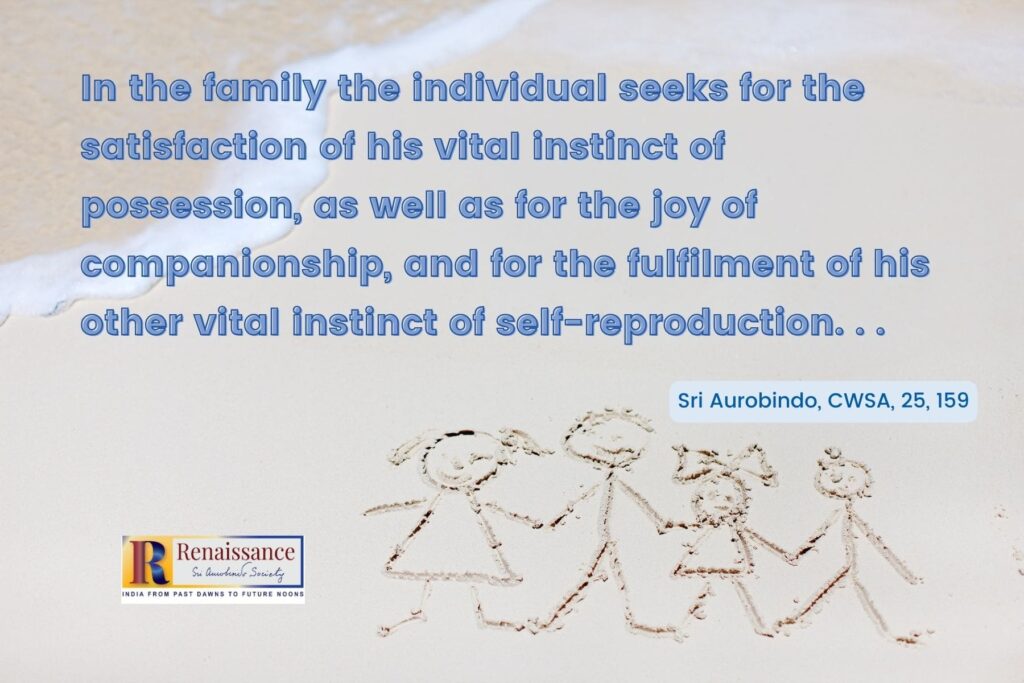
It may also be added here that as per the tradition, there was also a choice for someone to skip the householder or grihastha stage of life. One could go straight to sannyasa stage of life, thereby renouncing worldly and materialistic pursuits and dedicating one’s life to spiritual pursuits. This was generally more common for men than women. But the Indian tradition has plenty of evidence regarding women rishis and sages who chose this path of renunciation.
Significance of the Householder Stage
While some ancient texts refer to only three stages of human life – Brahmacharya, Grihastha and Vanaprastha, other later texts specify four stages of human life. Regardless, all the four stages are recommended as path to the highest aim of life – that of oneness with the Brahman, the Supreme Transcendence.
Most of the insight and discussion on different aspects related to individual and collective life and conduct of life is found in texts known as Dharmasūtras and Dharmasmritis.
From a sociological perspective, Indian cultural tradition – textual and practice – considers grihastha stage as the most important of all stages. This is because it is householders who essentially contribute to the maintenance of people in other stages of life – brahmacharya, vanaprastha and sannyāsa. In addition to pursuing a virtuous, dharmic life, individuals in this stage produce wealth that sustains people in other stages of life.
Additionally, through the activity of procreation and consciously raising and educating children to be good adults is one of the biggest contributions an individual makes to the society. It is also during this stage of life that the individual experiences most intense physical, sexual, emotional, occupational, social and material attachments. The overall stability and continuation of familial, communal, and societal arrangements are dependent on the householders.
Both Gautama and Baudhayana, the authors of the earliest dharmashātras, considered the grihastha-ashrama as the most important stage of life. For example, Gautama Dharmasūtra in verses 3.2 and 3.3 declares that the householder stage is the foundation of all the stages, and essential to the existence and continuation of society because the other three ashrams do not produce offspring.
Several other thinker-sages like Manu, Vasishtha and others looked upon the family as the nucleus of social order. In verses III.77 to III.80, Manusmriti declares grihastha stage as noble and excellent and says that just like all beings need air to survive, so do all beings take life from the householders because of the food they produce and knowledge they apply.
The Mahābhārata and the Householder
The Indian Epics, the Ramayana and particularly the Mahābhārata have extensive debates on grihastha stage of life. Chaturvedi Badrinath writes: “In discussing the life of the householder, the griha-astha, ‘the one living in family’, the Mahabharata is concerned with the foundations of family life everywhere as a human attribute” (The Mahabharata: An Inquiry in the Human Condition, 2007, New Delhi: Orient Longman, p. 336).
Breaking away from the legislative and prescriptive nature of the earliest dharmasūtras which were more focused on prescribing detailed rules and rituals that a householder was supposed to perform, the Mahābhārata concentrates on relationships and not on ritualistic acts, says Badrinath. “It is a systematic inquiry into the foundations of relationships, personal and social, which support, sustain, an enhance life: their dharma. It Is therefore at the same time an inquiry also into what uproots, degrades, and does violence to life’ the adharma of relationships, their disorder.” (p. 339).
This is precisely why the two epics – Ramayana and Mahabharata are considered as dharmashastras – scriptures that teach of dharma and help people live a dharmic life.
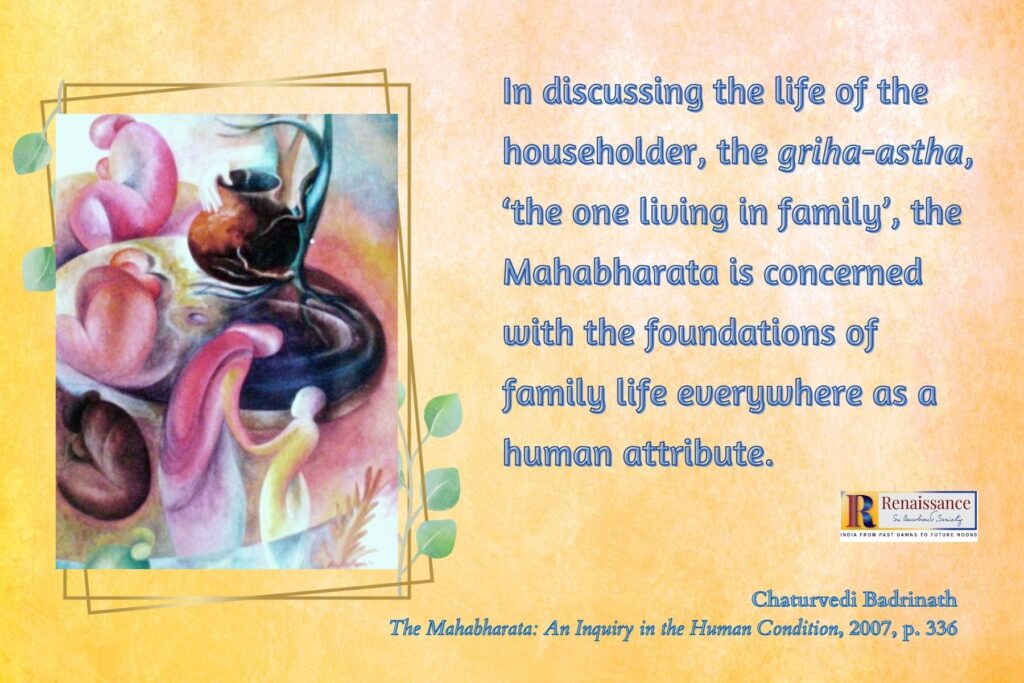
The Mahābhārata speaks of the demanding and exacting nature of life as a householder and says, “so demanding is its discipline that it is described, in one word, as dushkara, that is ‘exceedingly difficult’, ‘arduous’.” (Badrinath, p. 347) For example, in the Shanti Parva, we find the following verse:
आश्रमांस तुलया सर्वान धृतान आहुर मनीषिणः।
(शान्ति पर्व, १२. ११ – १२. १३)
एकतस ते तरयॊ राजन गृहस्थाश्रम एकतः ॥
समीक्षते तु यॊ ऽरथं वै कामस्वर्गं च भारत।
अयं पन्था महर्षीणाम इयं लॊकविदां गतिः॥
इति यः कुरुते भावं स तयागी भरतर्षभ।
न यः परित्यज्य गृहान वनम एति विमूढवत ॥
Translation: Once the wise weighed in a scale the relative weight of the four stages of life, and kept life-in-family on one side and the other three on the other. Weighing them on the scale of close analysis, life-in-family was found to be of greater weight; for it is in that the fulfilment of desires and the higher purposes of life, the earthly and the heavenly, get combined.
There are several other references in the text alluding to this high status given to the householder stage in life.
It is significant to note however that the Mahabharata assigns pre-eminence to the life-in-family also, or rather primarily, “because the family is the very first natural context in which life begins and where human beings grow as persons. At the same time, it shows, not any one place but throughout, that marriage and the family are not in themselves any hindrance to the seeking of spiritual freedom, which both come, the freedom and hindrance to it, from within one’s own self.” (Badrinath, p. 349)
In the Southern Recension of the Mahabharata (the Kumbhakonam edition), in a beautiful dialogue between Shiva and his consort Uma in the Anushasana Parva, we find the following verses:
शीलवृत्तविनीतस्य निगृहीतेन्द्रियस्य च।
(अनुशासनपर्व, 13.211.47-49)
आर्जवे वर्तमानस्य सर्वभूतहितैषिणः॥
प्रियातिथेश्च क्षान्तस्य धर्मार्जितधनस्य च।
गृहाश्रमपदस्थस्य किमन्यैः कृत्यमाश्रमैः॥
यथा मातरमाश्रित्य सर्वे जीवन्ति जन्तवः।
तथा गृहाश्रमं प्राप्य सर्वे जीवन्ति चाश्रमाः॥
Translation: Who has the nobility of conduct and humility of spirit; has disciplined his physical senses and mental faculties; is simple and straightforward; has in his hearts the good of all beings; offers affectionate hospitality to his guests; is forgiving; and who has earned his money in accordance with dharma – what need has such a householder of any other ashrama? Just as all living beings live with the protection of the mother, so do all other stages of life live with the householder as their support.
Thus, we see that the ancient texts give a lot of emphasis on the dharmic way of life to be pursued by the householders.
In fact, the grihasthashrama is considered as the noblest context in which to pursue the goals of artha and kāma in the light of dharma and always keeping in consideration the highest goal, that of spiritual liberation. This emphasis on dharmic living is also carried over to the goal of wealth generation by the householder.
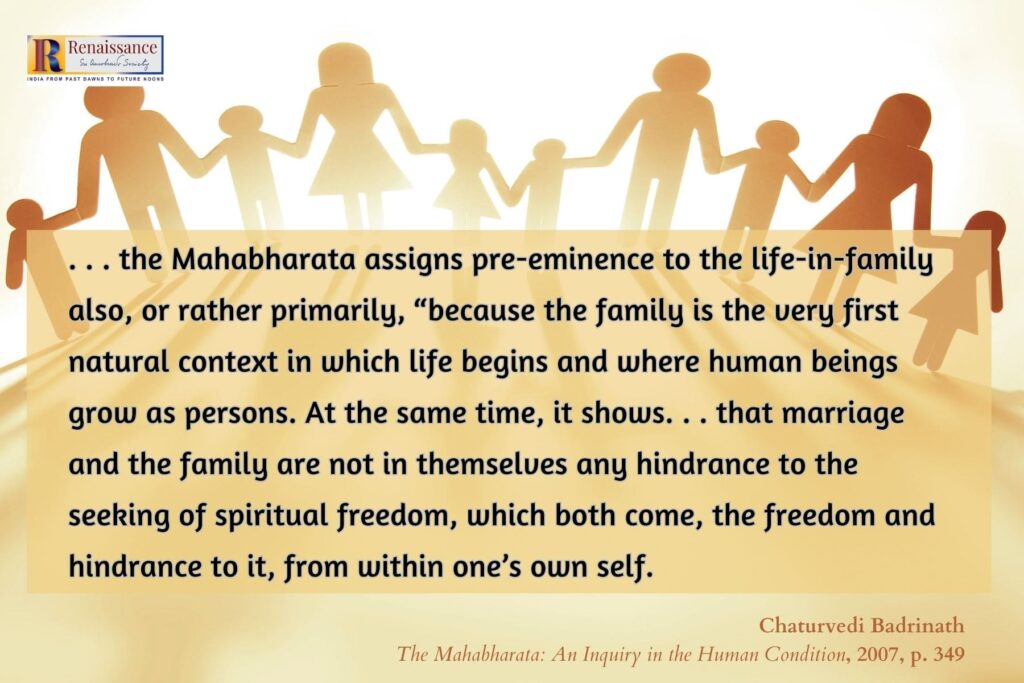
Ethical Wealth Generation
One of the key roles or duties of a householder is to generate wealth through ethical means. Poverty was never an ideal to be pursued by the householders, as per the ancient Indian wisdom.
The ancient dharmasutras and other texts clearly mention that one should accumulate property by ethically pursuing an occupation suited to one’s temperament and aptitude. A person in the householder stage of life must seek a means of living that causes no injury or least possible injury to all living beings, except in times of distress. Manusmriti further disapproves of servitude, slavery as means of survival for the householder.
Let us look at a few verses from Shanti Parva of Mahābhārata, which speak of this issue of ethical generation of wealth.
न धर्मार्थी नृशंसेन कर्मणा धनमर्जयेत् ।
(शान्ति पर्व, २८१.५)
शक्तितः सर्वकार्याणि कुर्यान्नर्द्धिमनुस्मरेत् ॥
One should not gather wealth by doing cruel deeds. The best thing is to make efforts to one’s best capacities, and not be anxious how to make the most money. (Translation as included in Badrinath, 2007, p. 290)
येऽर्था धर्मेण ते सत्या येऽधर्मेण धिगस्तु तान् ।
(शान्ति पर्व, २८१.१९)
धर्मं वै शाश्वतं लोके न जह्याद्धनकाङ्क्षया ॥
Only that wealth is truly wealth that has been earned in the ways of dharma. What has been collected through adharma to others is a wealth damned. One should not, in one’s greed for money, abandon what is universally right and good. (Badrinath, p. 290)
न्यायागतं धनं वर्णैर्न्यायेनैव विवर्धितम् ।
(शान्ति पर्व, २८१.४)
संरक्ष्यं यत्नमास्थाय धर्मार्थमिति निश्चयः ॥
The wealth that has been lawfully earned, and lawfully increased, is also to be preserved with care – in order to secure the good of others. This is certain.
To summarise, the teaching repeated throughout the dharmashāstras and niti-shāstras (prudence literature) of India has been that one should not seek material prosperity at the expense of others.
Obligations and Duties – The Three Debts
The life-in-family places enormous responsibility on people and demands sincere and hard work toward temporal and spiritual goals. The householder is supposed to live in the world but not let the world live within himself/herself. In other words, the individual is supposed to live through the stage of the householder without sacrificing his or her higher goal in life – that of a spiritual pursuit.
This means that while the individual lives and works in the society which regards personal possession as a mark of one’s success and achievement, accumulates wealth for the good of his family and the welfare of the society, he doesn’t succumb to the temptations of a materialistic life. This he is able to do when he always keeps the ideal of dharmic living as a guiding truth.
In many of our ancient texts we find references to the appropriate duties of a householder. For example, as per Book 3, chapter IX of Vishnu Purana a householder must discharge to the best of his ability all the duties appropriate of this life stage. These duties also include:
- honouring one’s ancestors,
- performing the recommended rituals and ceremonies to propitiate the gods,
- being hospitable to guests, performing charity,
- honouring the sages and other holy men and women,
- pursuing scriptural study for one’s inner growth,
- being truthful,
- raising healthy and noble progeny,
- taking care of weak, elders, sick and others who are physically or financially dependent,
- being kind to animals,
- practicing no harm or injury, and
- leading a dharmic life.
The dharmasūtras as well as the Mahābhārata describe in detail the duties of a householder. These duties are not only of one family member towards the others, but also of the family as a whole toward the society. As Badrinath writes:
The foundation of the family relationships is not the individual will and its changing content, but obligation and its unchanging form. Members of a family remained united by means of duties that were held to be sacred and not merely civil. Those duties were to be met irrespective of character and circumstance.
(Badrinath, 2007, p. 350)
For example, no matter what the character or the circumstances of a father or mother might be, their children owed to them certain duties. Similarly, the parents owed to their children certain duties. Providing protection, loving care, a disciplined upbringing, and honest advice were the duties of the parents towards children; obedience, holding them in honour, and looking after them in their old age were the duties of children toward parents.
Some of the obligations of the family toward others in the society include:
- Kindness toward all
- Charity
- Hospitality toward the guests
- Protection and care of animals, particularly those that did not belong to any one
- “The householder is obliged not only to the living, but to the dead as well, and also to the gods of the universe. Just as he eats only after the others in the family have eaten, he does not eat without first making a symbolic offering to the ancestors and to the gods who are the elements of Nature: the earth, the space, the sun, the wind and the fire. These are not to be simply ritualistic acts but are meant to invoke a feeling of oneness with so much else in which a family is sustained.” (Badrinath, p. 351)
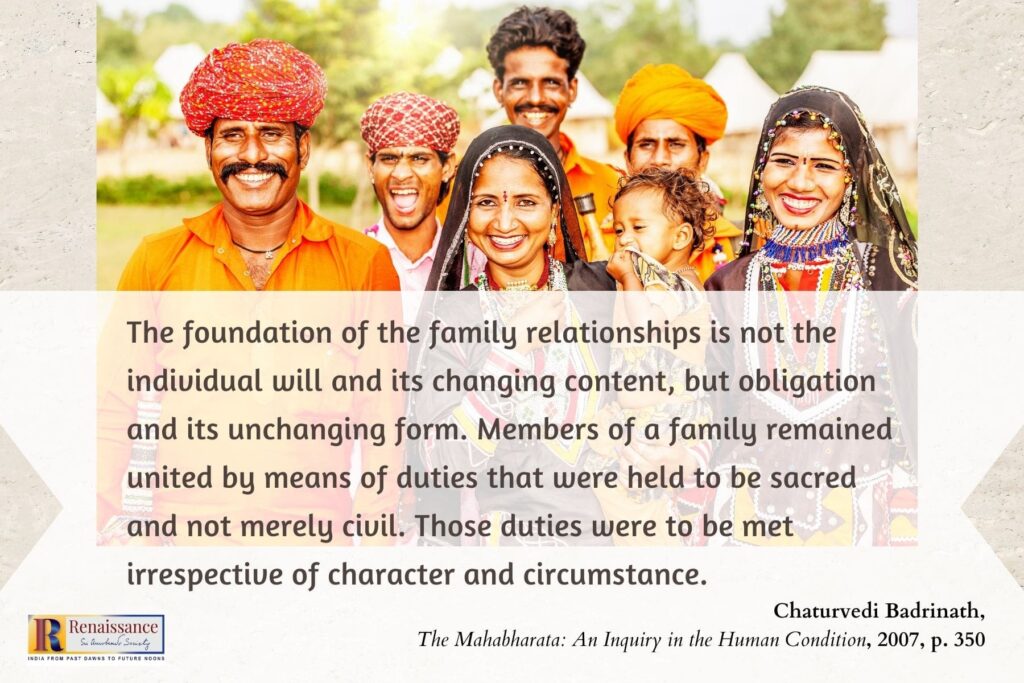
It is however significant to note that as per the Indian tradition these obligations and duties are neither arbitrary nor capricious. Their foundations are in the ancient concept of ṛṇatrya or ‘three debts’ as described in various texts such as Taittirya Upanishad and Satpatha Brāhmana:
- Deva-ṛṇa – debt to the gods: It is repaid by the performance of yajñas.
- Pitṛ-ṛṇa – debt to one’s ancestors: It is repaid by raising a family and by doing śrāddhas or other ceremonies to honour the ancestors.
- Rṣi-ṛṇa – debt to the sages, gurus or teachers: It is repaid by svādhyāya, by pursuit of knowledge and by contributing further to the advancement of knowledge.
Every person owes these debts and they must be discharged. To these three, two more are added.
- A debt to guests, for a person has been himself, or herself, a guest in another household, and has been received with feelings of respect and affection.
- Ātma-ṛṇa – debt to the jīvātman, debt to one’s self. This is repaid by taking proper care of the body-mind-soul complex and by pursuing spiritual growth.
Time-spirit demands New Forms
In the ancient Indian vision of human and social development, the whole of life is viewed as an evolutionary pilgrimage to the Spirit, moving towards the highest self-realisation. All individual and collective endeavour of man, his society, economics, politics, religion, culture and spirituality are viewed as part of his unconscious or conscious striving towards this spiritual goal.
All human life is a field of education, training and experience which gradually prepares the human soul for the highest goal. The primary aim of Indian socio-political thought and practice has been to evolve a social system which would help the individual and communal life of man to grow consciously towards this highest spiritual ideal.
But the present age and especially the coming future age requires that we correct whatever shortcomings there might have been in this form of individual and social development model, while keeping intact its essential spirit and the highest ideal for human life and its goal.
The time-spirit today demands that the spiritual ideal should not be pushed towards the last stage of life and as a pastime for the old. It has to be held before all people, young and old and the whole society, as the ideal to be consciously pursued. If we want to create a morally and spiritually healthy future for humanity, the young who are the creators of the future must be inspired with the spiritual ideal.
When we are young, we are in the fullness of vitality, vigour and energy, which is essential for a sincere spiritual aspirant. As we grow older, the vital energy begins to wane. The spiritual quest for the highest aim of life, therefore, must begin in the very first stage of the brahmachārin, which means in the school.
The young learner must be given a clear understanding of the highest spiritual aims and values of life and provided with an integral discipline.
This will help him or her consciously progress towards the spiritual aim through work, life and action. This necessitates that parents and adults in-charge of taking care of the growing children must first be conscious of this aim of life. Not only that, they themselves must be sincere aspirants on the path of seeking higher goals in life. Only then, they can be the right example and influence for the children.
This means that the aim of the householder should not merely be to fulfill social responsibilities. The deeper aim must be to make the social responsibilities a conscious means, process, preparation or education for progressing towards the spiritual ideal.
In other words, raising a family or the householder stage can be seen as a path of psychological growth leading to the development of the faculties, capacities and qualities of the mind, heart, will and action. For example, it can and must become the means where the capacity for wielding power and wealth is infused with a sense of responsibility and values. Similarly, the emphasis must be on experiencing enjoyment with restraint, or pursuing human relationships with harmony and love.
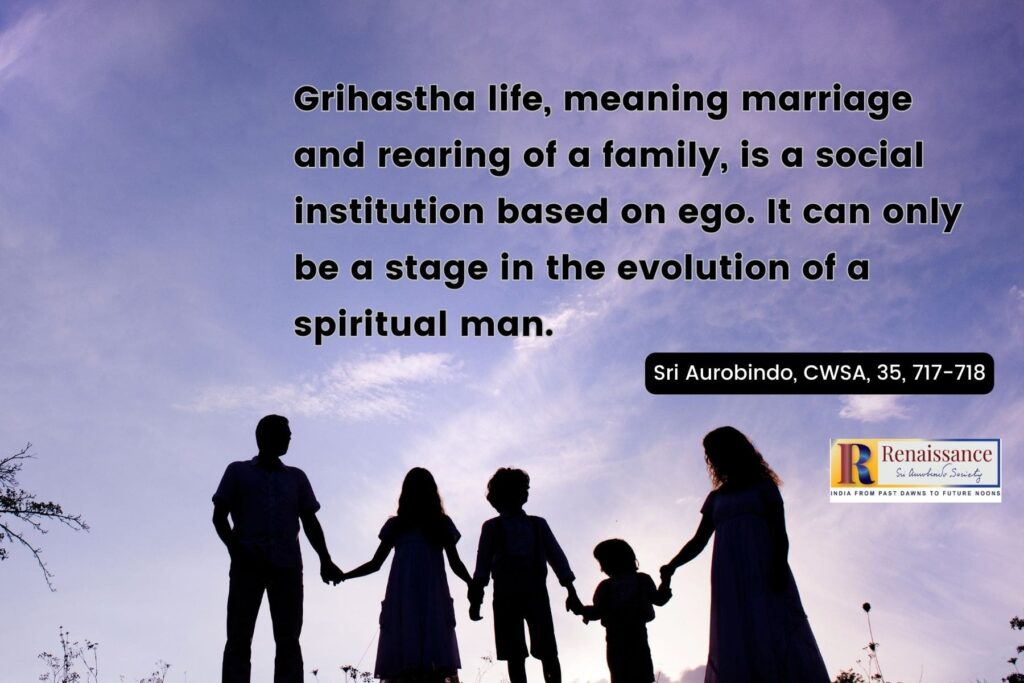
Also, the aim of the last two stages of life must not be merely to gradually withdraw and ultimately retire from life. These stages should be means to provide sufficient space for a more intensive and concentrated inner contemplation on the ultimate aims of life or inner communion with the spirit or divinity. This intensive inner communion should not lead to an inner escape into an otherworldly nirvana but to a greater manifestation of the inner gains in the outer life.
In the final stage, the undue emphasis on outer renunciation as the means of spiritual development must also be rethought for the coming age.
Though some of the Indian scriptures like Bhagavad Gita laid a greater emphasis on inner renunciation, after the advent of Buddhism the ideal of world-negation and outer renunciation somehow impressed themselves more upon the Indian mind as the sign of the highest spirituality.
But the future integral age requires that we go back to the viewpoint of the Gita with its emphasis on the inner renunciation of ego and desire as the sufficient basis for spiritual liberation and perfection. However, all are not capable of this highest inner renunciation. In fact, this inner renunciation is much more difficult than an ascetic outer rejection of life. Therefore, the graded and graduated approach of the ancient Indian scheme still has a practical validity.

~ Design: Beloo Mehra

